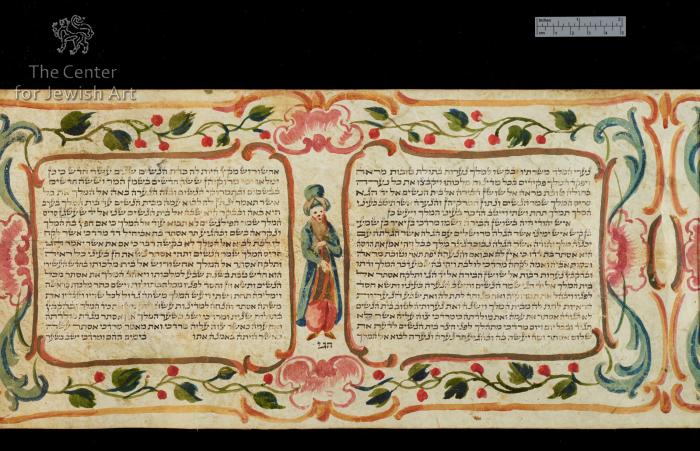Obj. ID: 37069 CUL Hanging of Haman Esther Scroll, Italy, 19th century

The length of the sheets in the scroll: 1) ca. 980 mm, 2) ca. 640 mm, 3) 640 mm, 4)415 mm, 5) ca. 400 mm, 6) at least 710 mm.
Dimensions of the selected details in the scroll:
- opening decoration: ca. 160 mm (width);
- decorations in the margins: ca. 40 mm (height);
- decorations between the panels: 32-65 mm;
- text panel: ca. 125x155 mm;
- figures of the heroes: ca. 95 mm (height);
- an average letter: more than 2 mm (height).
The rod: ca. 230 mm (height).
The right edge of the first membrane is trimmed into a decorative shape that is filled with the only narrative scene appearing in this scroll - the hanging of Haman (Es. 7:10). The text panels, on the upper and lower margins, are surrounded by floral ornaments and they are flanked by Rocaille motifs and full figures of the Esther story protagonists. They all are men wearing turbans and long gowns and they are named in Hebrew, except for the last one. The same decoration appears on all membranes in the scroll.
To the left edge of the last membrane, a wooden rod is attached.
The Book of Esther in Hebrew
The scroll is formed of 6 sheets containing 17 columns of the text with 17 lines, except for col. 14 with 11 lines divided into two parts.
The number of columns per sheet: no. 1 - 4, nos. 2 and 3 - 3, nos. 4 and 5 - 2, no. 6 - 3.
The text is inscribed in the Hebrew square Italian-Sephardi script with tagim, in black ink, on the flesh side of the parchment membranes that are of medium thickness. The flesh side is matte and brighter than another side that is darker, more yellow, and slightly shiny, therefore it is easy to distinguish between both sides of the sheets.
The letter ח (Es. 1:6) is highlighted by its form (it contains two elements joined with a roof) and size (it is larger than an average letter in the scroll). The letter ת (Es. 9:29) is enlarged.
In the text, there are two extremely elongated letters.
The text ends in the mid of the last line of the text.
The ruling is made with a hardpoint, only inside the text panels. The lines are barely visible; they are more visible on the blank spaces.
The membranes in the scroll are stitched.
None
The frames of the text panels could be originally painted gold.
Stefan C. Reif, Hebrew manuscripts at Cambridge University Library: a description and introduction, Cambridge 1997, 51-52.














